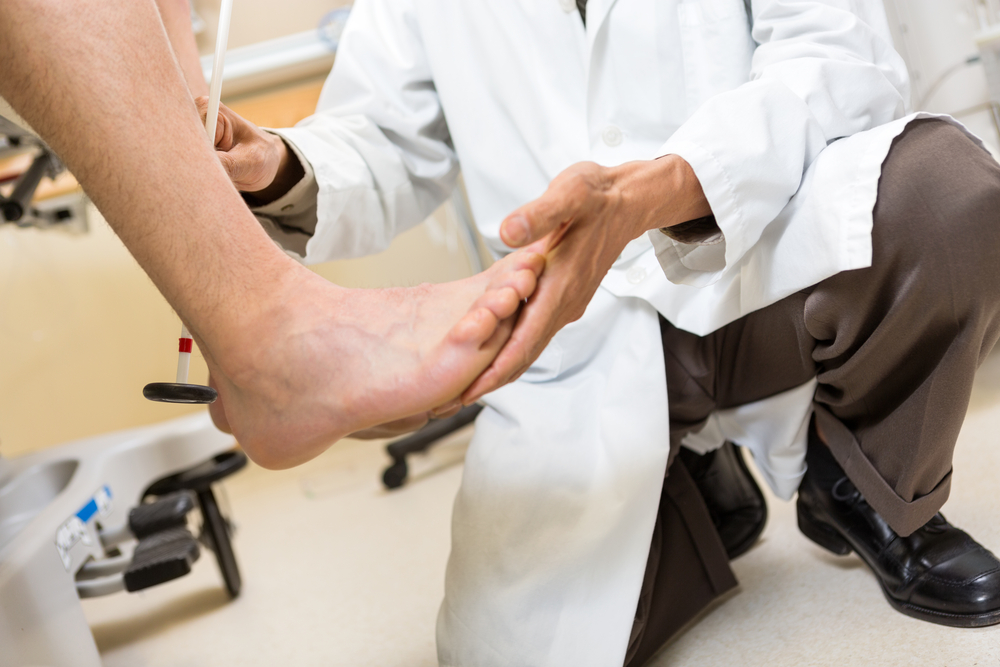For people living with diabetes, having an overabundance of glucose in your blood for long periods of time can cause serious foot problems. While many people can have a variety of concerns about their feet, those with diabetes have an increased risk of these issues leading to complications or serious infection. Knowing the kinds of symptoms to look for will allow you to seek help from a foot doctor nearby in Victoria, BC as soon as possible.
12 Common Diabetic Foot Problems That Need Attention From Your Foot Doctor in Victoria, BC
1. Sensory Diabetic Neuropathy
If you are unable to feel pain or hot and cold sensations in your legs and feet, you may have nerve damage caused by uncontrolled diabetes. The lack of feeling in these extremities is sensory diabetic neuropathy.
When nerves are damaged, our bodies cannot properly warn us of pain due to cuts or sores, which may result in the open wound becoming infected. For instance, if you cannot feel that you have stepped on a piece of glass, you may not realize you have a cut that needs to be cleaned, which then allows bacteria to grow.
2. Peripheral Vascular Disease
Diabetes also directly affects blood flow, causing cuts and sores to take longer to heal. This poor blood flow throughout the arms and legs is peripheral vascular disease. If you develop an infection that cannot heal due to poor blood flow, you will be at risk of ulcers and dead tissue.
3. Fungal Nail Infection
Discoloured toenails may be infected with a fungus. If you notice your nails have begun turning yellowish-brown or have become thick or brittle, you have a fungal nail infection. Damaged nails may start to separate from the rest of your nail bed, possibly even crumbling.
An injury to your nail can fester inside of your shoe, as shoes create a moist, warm, and dark environment that helps fungus grow. Nail issues can be tough to treat, but your doctor can get you started with a medication to clear up the infection and may even remove some of the damaged nails.
4. Athlete’s Foot
As with nail infections, fungus can affect the skin of your feet as well. This fungus causes redness, itching, and cracking, which opens up the skin allowing bacteria in. Medicines or creams prescribed by your foot doctor can kill this foot fungus.
4. Corns
Corns are the buildup of hard skin between the toes or near their bony areas, typically caused by the pressure of your shoes rubbing against your feet. Caring for them properly will keep them from worsening. The frequent use of a pumice stone after a bath or shower will help to gently remove any built-up tissue. Do not try to remove the corn with a sharp object or cut it off as this can create an infection.
5. Calluses
While corns develop around the toes, calluses are a buildup of hard skin on the bottom of your foot. Poor-fitting shoes, skin problems, or an uneven distribution of weight can all lead to calluses. The majority of adults experience calluses at some point in their lives, so your doctor will be able to evaluate yours and determine if it is causing problems.
Care for your callus by using a pumice stone on the built-up tissue and increase the cushion in your shoes. Do not try to remove the callus with a sharp object or cut it off as this can create an infection.
6. Blisters
Blisters form when your shoe rubs on the same spot of your foot continuously. Wearing shoes without socks or wearing shoes that don’t fit properly can cause blisters. Blisters can quickly become infected, so using an antibacterial cream is beneficial to treating the area. Apply the cream and cover with a clean, soft bandage, protecting the skin. It’s important not to break blisters and create an open wound.
7. Bunions
When your big toe leans toward your second toe, a bunion can form causing red and callused skin. The skin may become hard and protrude. This can happen on one or both feet, and while there is a hereditary component, bunions can also form from wearing shoes with narrow toes. High-heeled shoes with narrow toes, in particular, put pressure on your big toe, bending it toward your second toe.
You can protect bunions from irritation with felt or foam padding adhered to the inside of your shoe. If a bunion has gone untreated and allowed to continue to be exposed to irritation, it may cause severe pain. In some cases, untreated bunions can cause deformity that requires surgery to realign the affected toes.
8. Diabetic Ulcers
A deep sore or a break in the skin is a foot ulcer. Foot ulcers can begin as minor scrapes or cuts that don’t heal quickly enough to avoid infection. Ill-fitting shoes that rub the skin of your foot can also result in ulcers. Treating these wounds immediately and seeking advice from your doctor is imperative to maintaining healthy skin.
9. Dry Skin
Severely dry skin is prone to cracking, which allows germs and bacteria to enter the body. Keeping your skin moist and soft can be achieved with the regular use of moisturizing soaps and lotions, particularly after a shower or bath. Medicated soaps and lotions are also available through your doctor.
10. Ingrown Toenails
Ingrown toenails are caused by the edge of your nail growing into your skin. This growth increases pressure and subsequent pain along the nail edges. Along with pressure, the sharpness of the nail can cut into the skin, causing redness, pain, swelling, infection, and drainage. Uncomfortable shoes are the most common source of ingrown toenails. Other irritants such as improperly trimmed nails and repeated injury to the feet due to frequent running or walking can contribute to this foot problem.
Maintaining properly groomed nails will go a long way to preventing ingrown toenails. If a nail infection develops, seek immediate medical attention. If the problem is allowed to persist and worsen, surgery may be needed to remove part of the toenail.
11. Hammertoes
Weakened muscles can cause a toe to bend, resulting in a hammertoe. This weakened muscle shortens the tendons in your toe, making your toe curl under your foot. While hammertoes can be hereditary, the most common cause is from wearing shoes that are too short. If a hammertoe causes walking problems, then sores, calluses, and blisters can develop and need to be treated. In severe cases, surgery can be used to straighten the toes.
12. Plantar Warts
Plantar Warts are often mistaken for calluses in appearance, but this particular wound may have tiny black spots or pinholes in the center. Typically painful, these warts are caused by a virus that has infected the skin. Your doctor can diagnose and treat this affliction.
Proper control of your diabetes and adequate care for your feet can prevent or lessen these common foot problems. Call or come by Island Foot Clinics today and let us help match you with a doctor who will find a treatment plan that’s right for you. The right medication along with exercise and proper nutrition will keep your daily blood sugar levels within the doctor-recommended range and keep diabetic foot problems at bay.

